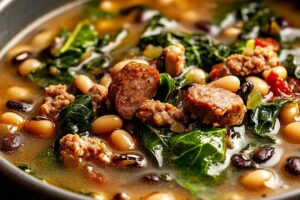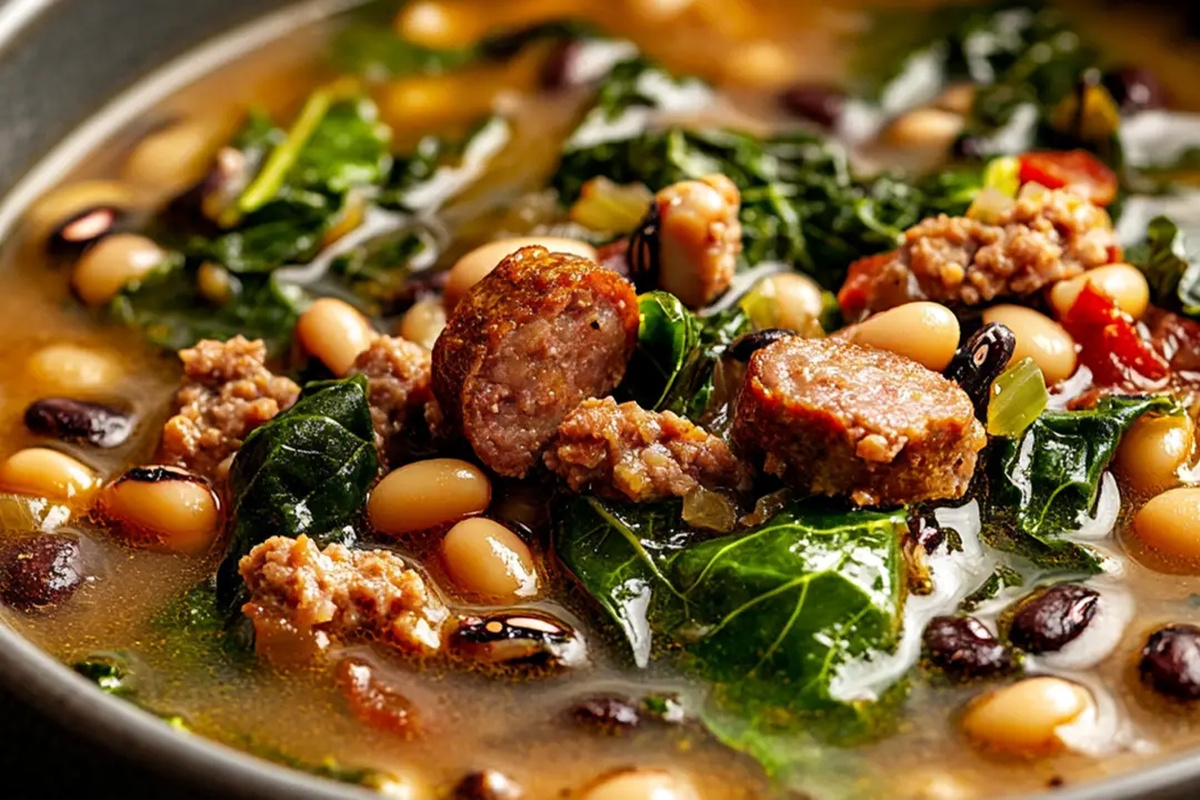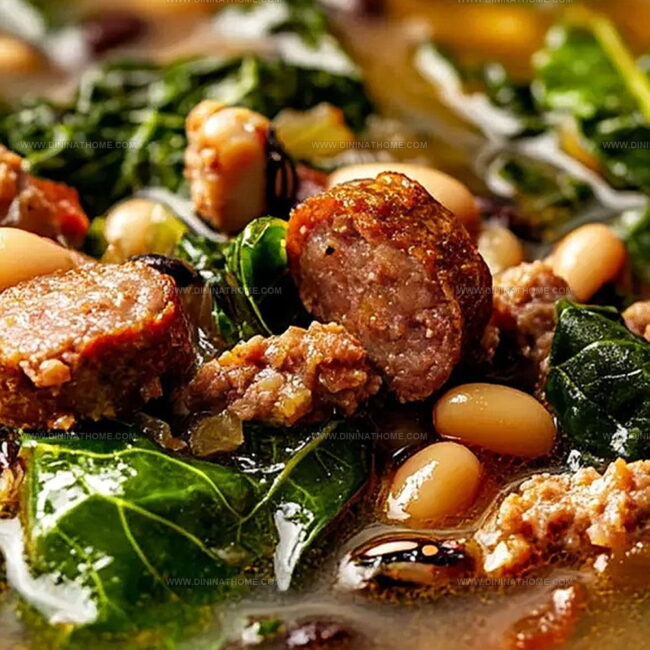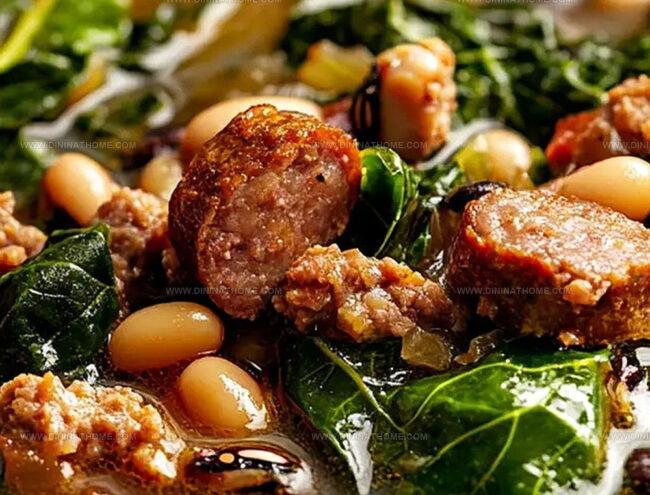Flavorful New Years Black-Eyed Pea Soup Recipe with a Twist
Hearty black-eyed pea soup brings Southern comfort straight to your winter table with robust sausage and tender collard greens.
Generations of cooks have perfected this classic dish that warms you from the inside out.
Regional traditions blend deliciously in this one-pot wonder packed with flavor and nutrition.
Smoky sausage chunks nestle among creamy beans and vibrant greens, creating a symphony of textures.
Savory seasonings infuse each spoonful with deep, complex notes that dance across your palate.
Rustic ingredients come together effortlessly, promising a meal that feels like a warm embrace.
Let this soul-satisfying soup transport you to a cozy kitchen where love simmers in every bite.
What Makes Black-Eyed Pea Soup So Comforting
Black-Eyed Pea Soup with Sausage & Greens – Ingredients
Protein Base:Greens and Vegetables:Liquid and Seasoning Components:Finishing Elements:Soup Prep for Black-Eyed Peas, Sausage & Collard Greens
Step 1: Soak and Prepare Black-Eyed Peas
Rinse the black-eyed peas thoroughly.
Place them in a large bowl and cover with cool water.
Let them soak for 4-6 hours to soften and reduce cooking time.
After soaking, drain and rinse the peas again to remove any excess starch.
Step 2: Brown the Sausage
Heat a skillet over medium-high heat.
Crumble the pork sausage into the pan and cook until it develops a deep golden-brown color.
Break the sausage into bite-sized chunks while cooking.
Once fully cooked, transfer to a plate lined with paper towels to drain excess grease.
Step 3: Build Flavor Base in Crockpot
Grab your crockpot and add the following ingredients:Step 4: Add Liquid and Seasonings
Pour in enough water to cover the ingredients, typically around 1 1/2 cups.
Season with:Stir everything together to distribute ingredients evenly.
Step 5: Slow Cook to Perfection
Cover the crockpot and set to low temperature.
Allow the soup to simmer for 10-12 hours, or overnight for maximum flavor development.
Stir occasionally and check liquid levels, adding more water if needed.
Step 6: Final Touches and Serving
Taste the soup and adjust seasonings.
If desired, add a splash of vinegar or extra spices.
Ladle into deep bowls and serve piping hot alongside warm cornbread for a traditional Southern-style meal.
New Year Soup Tips for Peas, Greens & Sausage Flavor
Reheat Black-Eyed Pea Soup with Sausage
Pairings for Black-Eyed Pea Soup & Sausage
Creative Twists on Black-Eyed Pea Soup
FAQs
Black-eyed peas are a Southern tradition symbolizing good luck and prosperity. Eating them on New Year’s Day is believed to bring financial fortune and ward off bad luck for the upcoming year.
Yes, absolutely! Fresh collard greens work perfectly. Just remove the tough stems, chop the leaves finely, and add them to the crockpot. They’ll cook down beautifully and add great flavor and nutrition.
The recipe has a mild heat level from Rotel tomatoes. If you want more kick, add a dash of hot sauce or include diced jalapeños. You can easily control the spice level to suit your taste preferences.
Andouille or smoked pork sausage are excellent choices. They add robust flavor and complement the black-eyed peas perfectly. Choose a sausage that’s not too lean to enhance the soup’s overall richness.
Print
New Years Black-Eyed Pea Soup With Sausage & Collard Greens Recipe
- Total Time: 10 hours 15 minutes
- Yield: 8 1x
Description
Hearty New Year’s Black-Eyed Pea Soup simmers with Southern charm, blending spicy sausage and tender collard greens. Comfort meets tradition in this lucky dish that promises warmth and prosperity for those who savor each delicious spoonful.
Ingredients
Main Proteins:
- 2 pounds (907 grams) pork sausage links, cooked in a skillet, then sliced
- 1 pound (454 grams) dried black-eyed peas, soaked for a few hours
Vegetables and Greens:
- 4 bunches collard greens, washed, ends trimmed, and roughly chopped
- 1 large can Rotel tomatoes
- 1 1/2 teaspoons minced garlic
- 1 tablespoon tomato paste
Liquids and Seasonings:
- 2 small cartons chicken stock
- 1 1/2 cups water (adjust as needed)
- 3 tablespoons apple cider vinegar
- 1 tablespoon or less sugar (to balance bitterness)
- Salt and pepper to taste
- Hot sauce (optional, for added heat)
Instructions
- Rinse black-eyed peas thoroughly and soak for several hours to reduce cooking time and improve digestibility.
- In a skillet, render pork sausage over medium heat until golden brown and slightly crispy, then slice into delicate medallions.
- Transfer sausage pieces into a spacious slow cooker, layering with drained black-eyed peas and freshly chopped collard greens.
- Pour chicken stock into the slow cooker, incorporating minced garlic, diced Rotel tomatoes, and tangy apple cider vinegar for depth of flavor.
- Whisk tomato paste into the liquid to create a rich, velvety base, then sprinkle a touch of sugar to balance the acidity.
- Season the mixture with kosher salt, cracked black pepper, and optional hot sauce for an extra kick of warmth.
- Cover and set slow cooker to low temperature, allowing ingredients to meld and tenderize over 8-10 hours.
- Periodically stir the soup, checking liquid levels and adjusting seasonings as the beans absorb stock.
- Before serving, taste and fine-tune with additional vinegar or spices to elevate the overall complexity of the dish.
- Ladle steaming soup into bowls and pair with warm, buttered cornbread for a traditional Southern New Year’s comfort meal.
Notes
- Enhance flavor by soaking black-eyed peas overnight in salted water to tenderize and reduce cooking time.
- Swap pork sausage with turkey or plant-based sausage for lighter, leaner, or vegetarian dietary preferences.
- Boost nutrient density by adding extra vegetables like diced carrots or celery during slow cooking process.
- Control sodium levels by using low-sodium chicken stock and monitoring salt additions throughout cooking.
- Prep Time: 15 minutes
- Cook Time: 10 hours (slow cooker)
- Category: Dinner, Lunch, Appetizer
- Method: Slow Cooking
- Cuisine: Southern (American)
Nutrition
- Serving Size: 8
- Calories: 320
- Sugar: 3 g
- Sodium: 850 mg
- Fat: 14 g
- Saturated Fat: 5 g
- Unsaturated Fat: 7 g
- Trans Fat: 0 g
- Carbohydrates: 35 g
- Fiber: 10 g
- Protein: 18 g
- Cholesterol: 60 mg




James Walker
Lead Recipe Developer & Culinary Educator
Expertise
Southern Cuisine & Farm-to-Table Cooking, Recipe Development & Testing, Culinary Education & Instruction
Education
School: Auguste Escoffier School of Culinary Arts
Program: Diploma in Culinary Arts and Operations
Focus: Comprehensive training in classical and modern culinary techniques, kitchen operations, and farm-to-table practices.
James didn’t learn cooking from a TV show, he learned it from busy kitchens, family gatherings, and long afternoons spent testing recipes the hard way.
After training at the Auguste Escoffier School of Culinary Arts, he brought his love for real, down-to-earth food to every dish he makes.
At Dining At Home, James loves building recipes that feel familiar but still have something special, like adding a twist to a classic or making a slow Sunday dinner feel brand new.
When he’s not in the kitchen, you’ll probably find him swapping garden tips at the farmers’ market or teaching his daughter how to flip pancakes without a mess (almost).